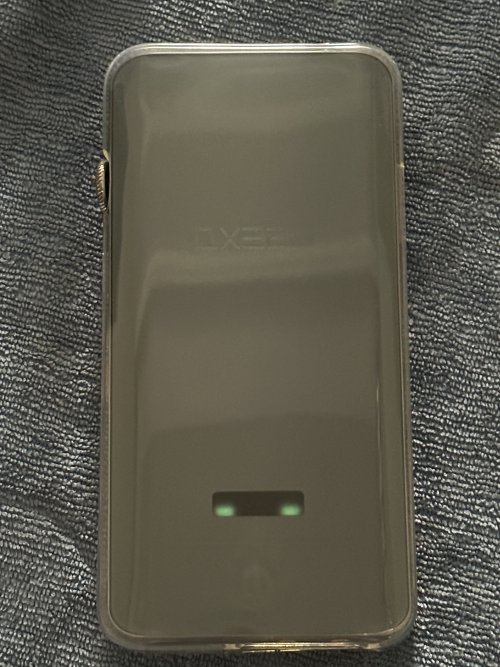Ricky64
100+ Head-Fier
From the Final Audio Website
A8000
final’s flagship model realizes transparent sound for the uplift that can be gained by listening to music
Development of the A8000 began with reconstruction of physical measurement and subjective evaluation methodologies. Under the subjective evaluation methodology established at the time of D8000's development, the E Series achieved sound quality highly evaluated by many people and became a best seller. With the A8000, a new evaluation index has been incorporated into that subjective evaluation methodology. Among factors that determine sound quality for earphones and headphones, amplitude frequency response is predominant, but there are some sound impression cannot be explained by it. For example, the most critically evaluated aspect of classical music recordings is called transparent sound, a sound impression by which sound is very clear even it is localized at a distant location. We have been considering the realization of this sound impression to be extremely important for becoming uplifted by listening to music. We believe that the high evaluation of our D8000 headphones owes to the realization of such transparent sound. Until now, we have employed modification of the amplitude frequency response, known as tuning, to modify the sound of our earphones, but because it cannot make a great change to time response, it became difficult to achieve transparent sound through tuning. This time, with the aim of achieving transparent sound for earphones, final has developed its own proprietary Perceptual Transparency Measurement (PTM) evaluation methodology. As a result of evaluation and improvement of interrelations between principal components analyized by the results of subjective evaluation and data analysis of impulse response that could not be gleaned from frequency response in the past, an ideal diaphragm material that is extremely light and possessing high sound speed comprised of ultra-thin Beryllium foil (Truly Pure Beryllium Diaphragm) has been adopted for the A8000.
Features
Adoption of Truly Pure Beryllium Diaphragm
The A8000 employs a diaphragm made from ultra-thin Beryllium foil (Truly Pure Beryllium Diaphragm), which is said to be an ideal diaphragm material due to its light weight and high sound speed. With a specific gravity of 1.85 and a sound propagation velocity of 12,900 m/s, second only to that of diamond, Beryllium has ideal characteristics for a diaphragm material. The adoption of pure Beryllium will lead to improved time response that greatly transfigures sound into transparent. The sharpness of sound build-up and the lingering resonance of the sound can be clearly felt, as can the silence between sounds. Crafting thin pure Beryllium foil is difficult. Our engineers had to struggle to make it stable enough for the product, but it can be said to be a valuable material that pays off our hard works. In order to realize transparent sound through such superior materials, the same high quality has been demanded of the other components of the drive unit as well as the design and manufacturing technology. We have succeeded in leveraging the experience of developing and manufacturing our own dynamic drive unit to draw forth the advantages of pure Beryllium. ※ In the past, a Beryllium diaphragm was created by vacuum deposition of a thin coat of Beryllium onto a resin film. This was effective as an improvement methodology, but the characteristics of the film remain predominant. When pure Beryllium is used as the only material for the sound producing part of the diaphragm, the sound and characteristics are completely different.
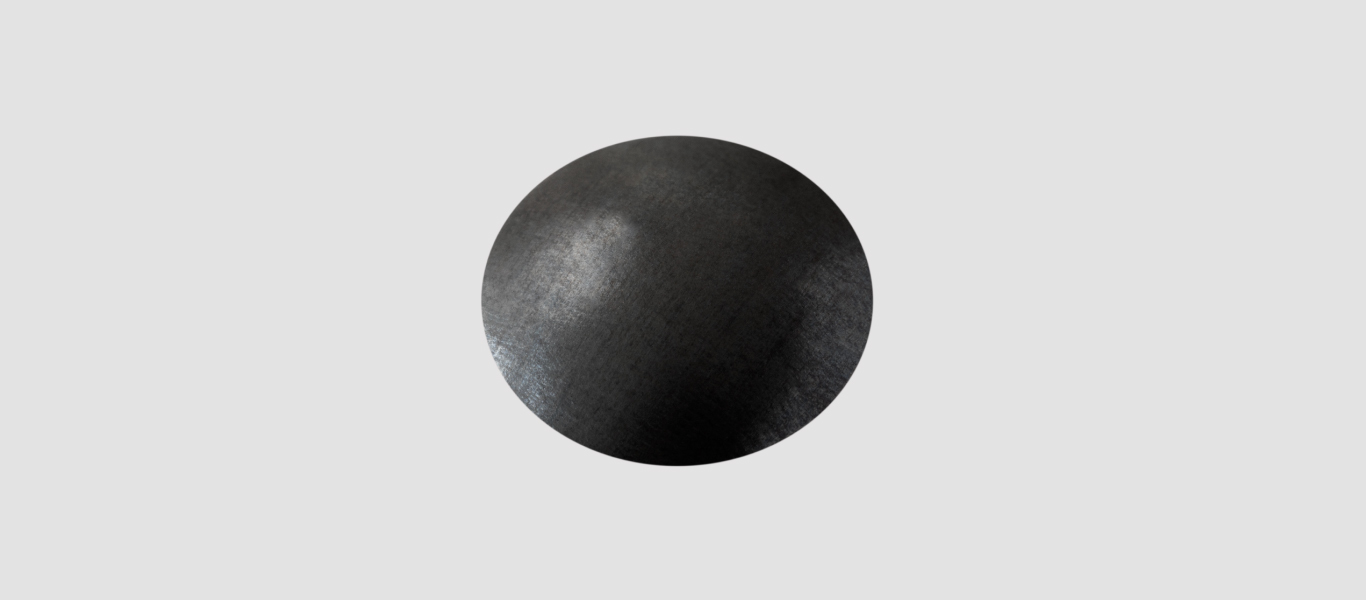
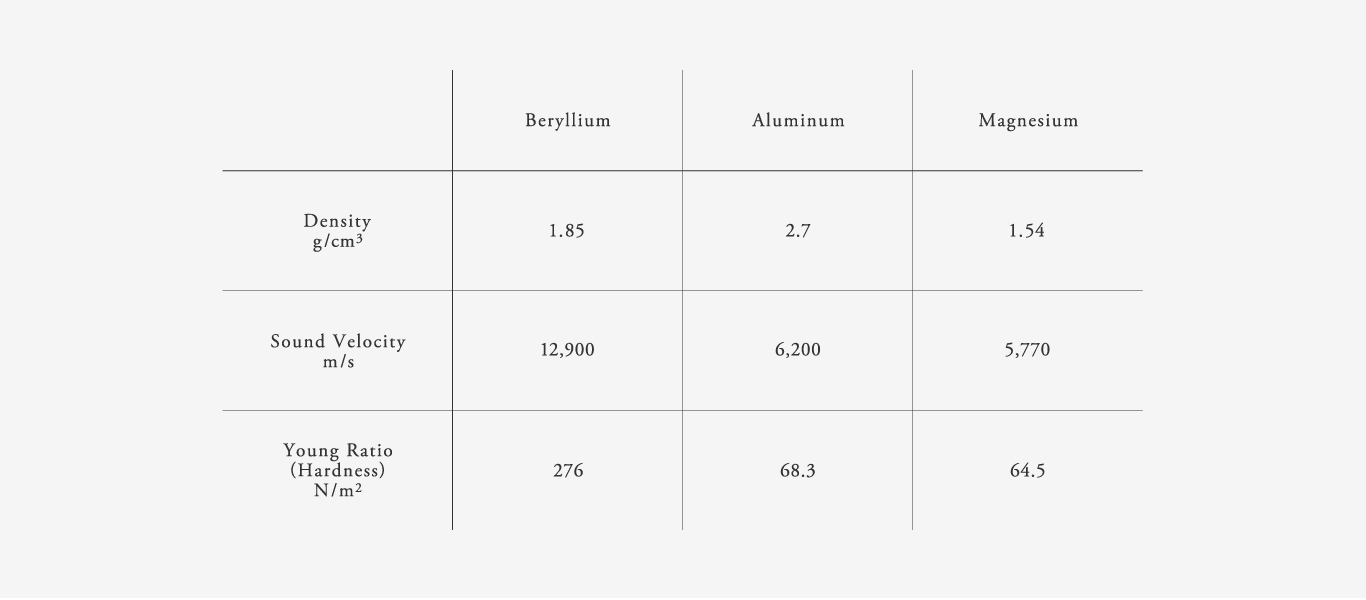
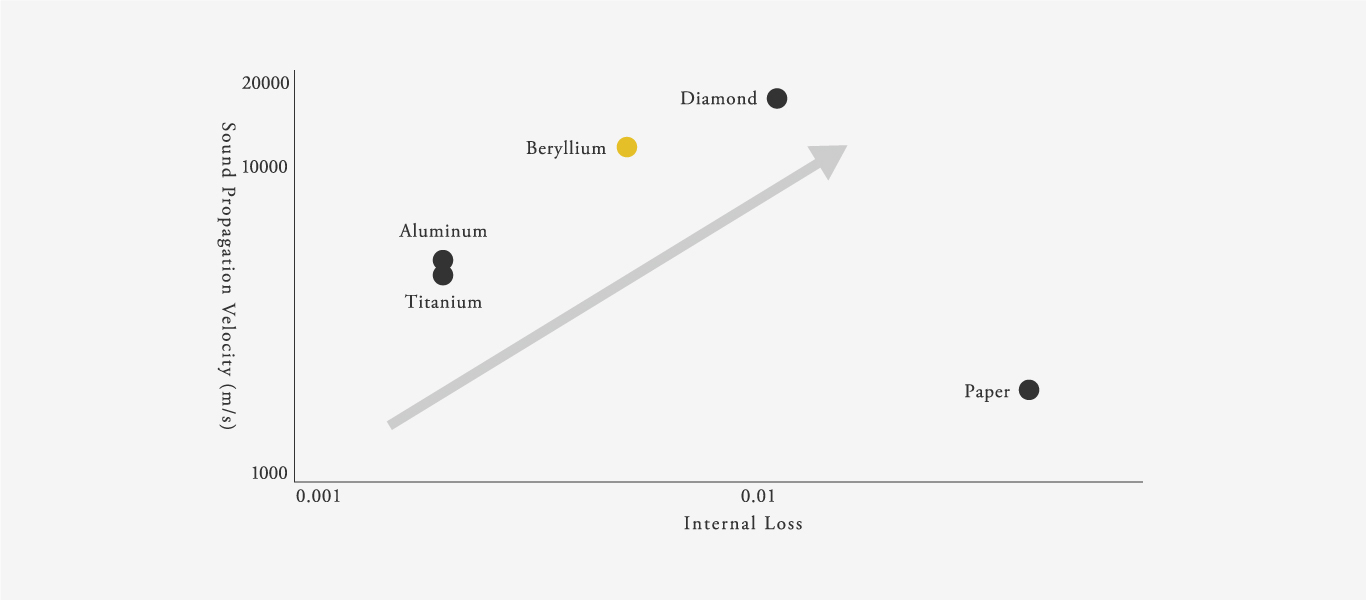
Balancing getting an uplift from a wide range of musical genres with universally good sound.
Sound design for these models has been undertaken with attention to the relationship between spatial impression and dynamic range of music, and the physical characteristics of earphones and headphones. We have categorized sound creation on music recording onto these two axes: spatial impression and dynamic range.
One way of thinking regards the distance perception. Classical and jazz recordings are thought to be performed with emphasis on aspects of spaciousness, such as sense of distance, broadness and reverberation. On the other hand, rock, pops and many of the recent animation soundtrack recordings, spaciousness is not as highly emphasized. There is thought to be greater emphasis on clarity, which brings the various instruments and vocals to the front.
Another approach is dynamic range - in other words, changes in loudness over time. If the dynamic range is wide, naturally it is possible to use the change in loudness over time to achieve a more dynamic expression of music. But, there are some types of music for which narrower dynamic range recordings are preferable to allow each of the instruments and vocals to ordinarily appear before the listener’s eyes.
The difference between these two ways of thinking pertains not to which is superior but rather differences in how music is composed and what is demanded of it. With regard to classical music, and that played by orchestra in particular, the spatial orientation of instruments is particularly important. Stringed instruments are positioned nearest to the audience with wind and percussion placed behind them. Should the balance between the spatial orientation and volume of each group of instruments collapse, the music would disintegrate. For that reason, uniform clarity of sound that allows each instrument to appear before the eyes of the listener is not demanded of this type of music. Even for classical music, a string quartet, for example, would have a narrow dynamic range and the clarity of each instrument would be more prominent. For rock and pops on the other hand, spaciousness is not as necessary as for classical music, and so there is greater emphasis on clarity than spaciousness.
These preconditions are very important, particularly for earphone and headphone listening, and it has become apparent that the implementation of appropriate target curves and driver design result in deeper enjoyment of music.
Please refer to the below graph with spaciousness and clarity of music set on the X axis and dynamic range set on the Y axis.
The superior time response of the A8000 imparts it with sound quality that is capable of providing an uplift from a wide range of music that approaches the extent of the D Series, from the clarity of pop and rock music with a narrow dynamic range all the way to the spatial impression of classical and jazz music with a wide dynamic range. The most distinct characteristic of the A8000 is that it realizes such sound quality not by its ability to create sound capable of attracting a small number of wild fans through its strong individuality, but rather sound aimed at greater universality.
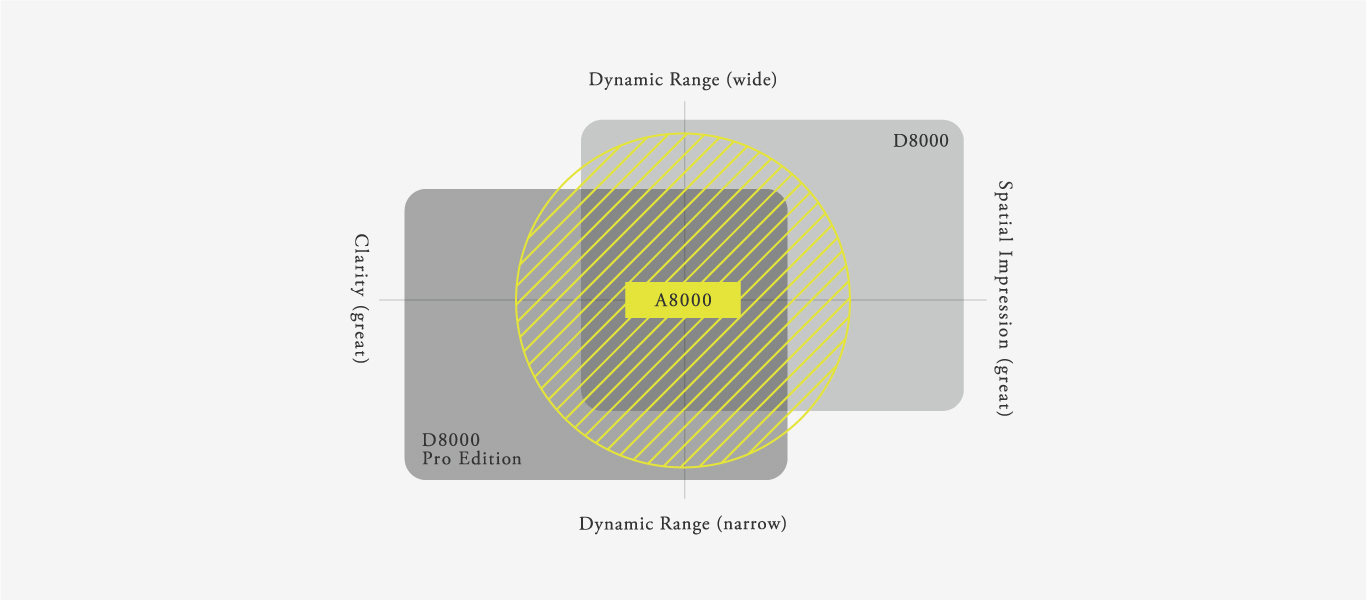
The Feeling of a Customized Fit
Based on the IEM chassis design developed for the B series that has become established as an ideal solution, the A8000 realizes a superior sense of fit. Whether or not the fit of earphones feels superior is determined by the sense of oppression. While at first glance it may seem correct to select an ergonomically praised organic shape to be held in place by the elasticity of silicon, this places ordinary pressure on the ear that serves as an unwary burden and leads to accumulation of fatigue. In limiting the area of contact in comparison to an organically shaped surface that comes in contact with a large area of the ear, this product aims for a sense of fit with no feeling of oppression. For that reason, it is suitable for the ears of many different people. If there is no feeling of oppression at any of the points of contact, that makes for such a comfortable, superior feeling of a customized earphone fit.
Precisely cut stainless steel chassis with "Tetra-Chamber Construction"
The volume and shape of the chambers in front of and behind the dynamic drive unit have a great impact on sound quality. Particularly, operation of the newly developed true Beryllium driver is extremely delicate, and it is impacted greatly by the spaces in the chassis. The internal design of the chassis can be calculated to some extent through simulations, but after that repeated trials of an actual product must be conducted until the sound quality targets are reached. For the A8000, in order to optimize operation of the driver, the inside of the driver unit chassis is divided into four chambers (Tetra-Chamber Construction); the driver ante-chamber and the double construction driver post-chamber and the MMCX connector portion are separated into different chasses. The driver is direct mounted into the ante-chamber of the chassis by a design that suppresses unnecessary vibration to achieve a distinct sound contour. Additionally, the use of four chambers achieves a balance between volume and tightness in the low-range while at the same time preventing leakage of sound.
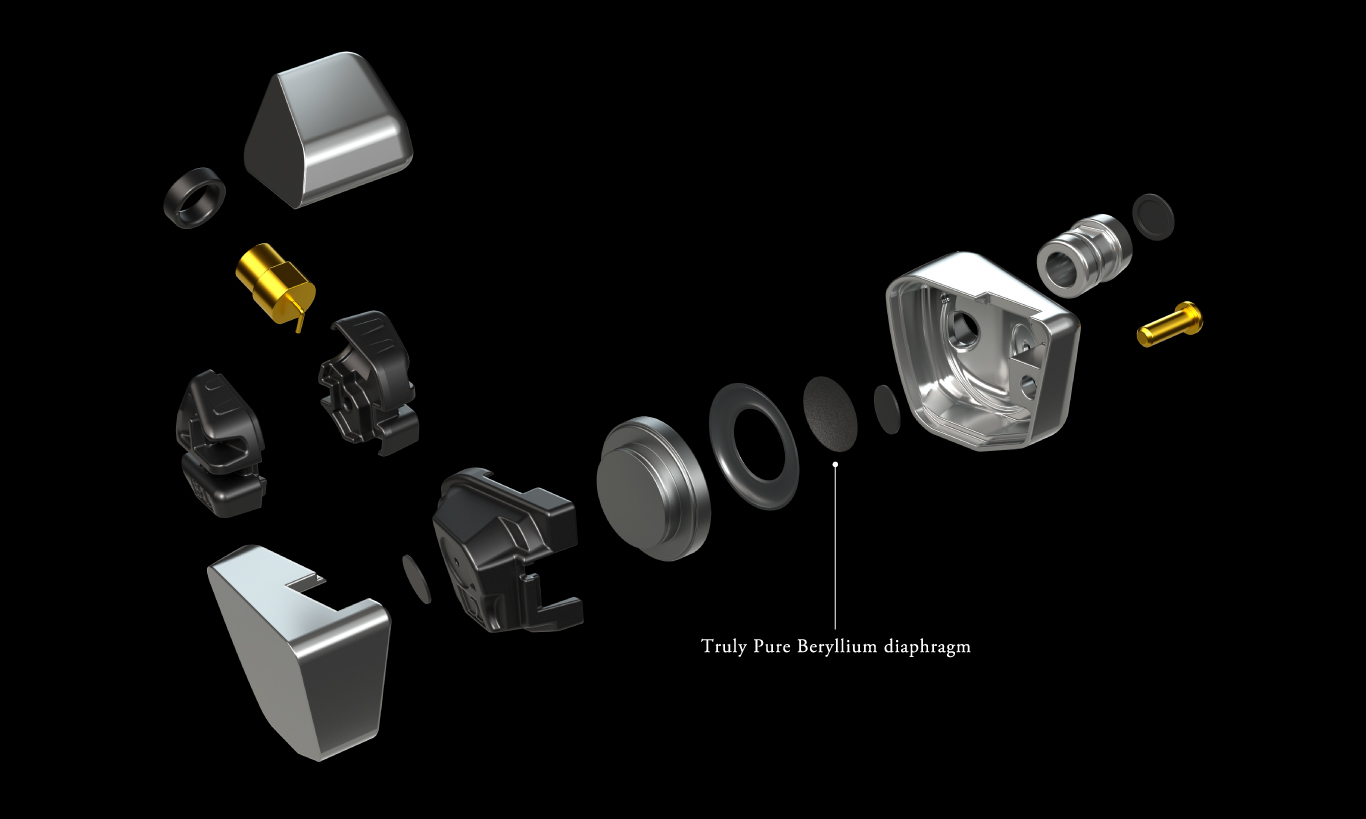
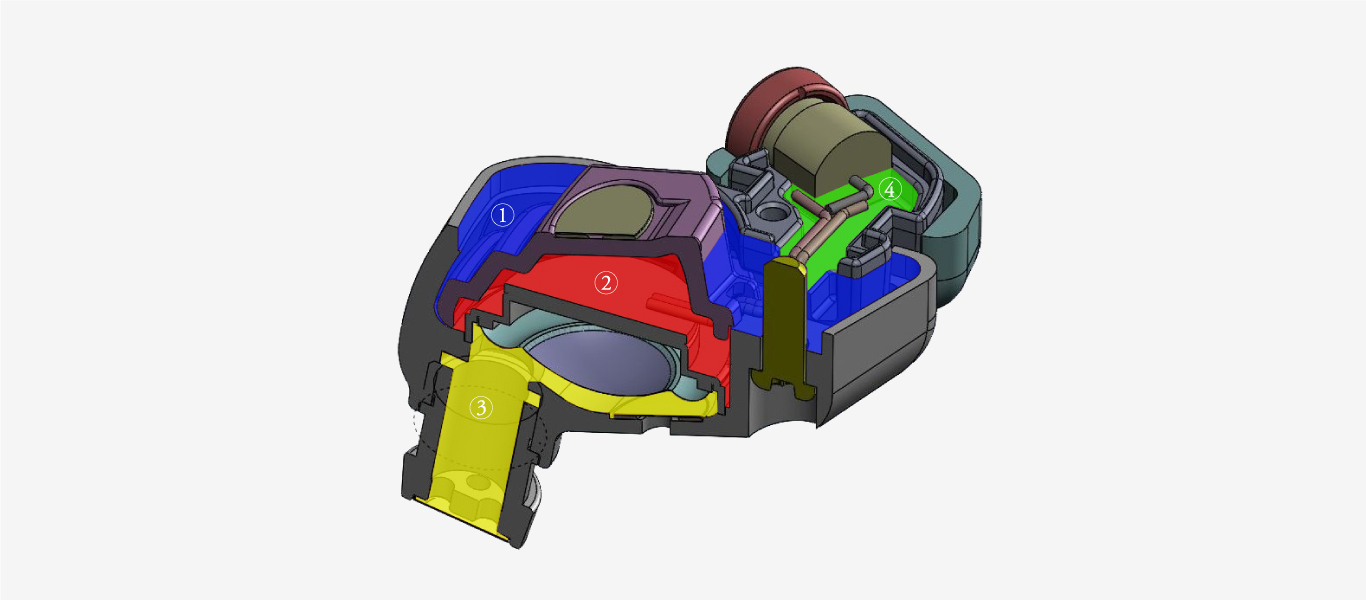
MMCX Connector&Original high purity OFC silver coated cable
The MMCX connector was developed in-company. We've used high-purity OFC silver coated cables that provide a wide sound stage. These jointly-developed cables were originally designed by and are currently manufactured by the well-renowned Junkosha corporation for the purpose of being used with the supercomputer "Kei" due to their fast signal transmission speed. The insulator film is made from PFA which was also developed by Junkosha who used their extensive know-how through the JUNFLON® brand to create the ultimate in low-permittivity material. The outer tube is made from PVC for maximum flexibility. The user will experience surprising flexibility that both makes the cable extremely easy to use as well as reducing the likelihood of microphonics. In addition, the MMCX plug and the 3.5 mm mini-plug have a tendency to disconnect so we've far exceeded the regular QA pass criteria of a 5,000-time bend test by changing the connection design to one that can withstand more than 50,000 bends.
* Junkosha: The Japanese corporation Junkosha develops and manufactures products such as high speed coaxial cables that boast the world's fastest transmission speed at 95% the speed of light, as well as cables for demanding fields such as marine and aerospace, healthcare and power generation facilities. These special cables require a high level of technology and center around fluoropolymers. Junkosha's cables are often called by the brand name JUNFLON® and have earned the tremendous trust of engineers requiring special-purpose cables.
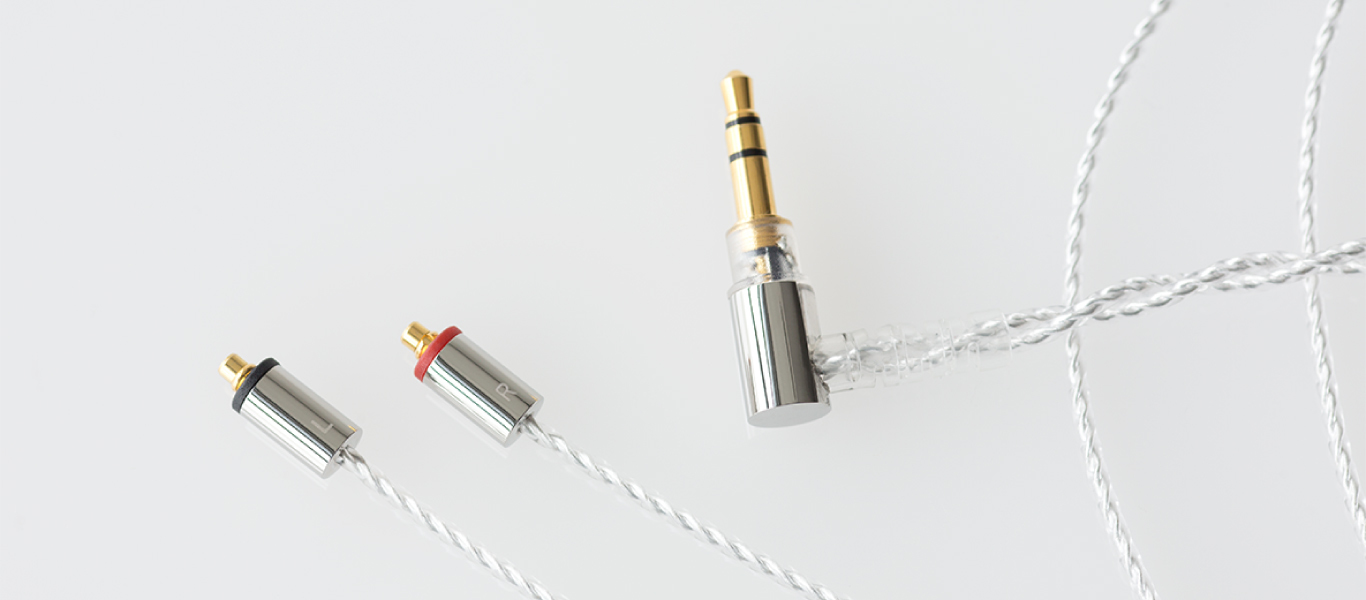
MMCX ASSIST for easy plug removal
An item for the smooth insertion and removal of earphone cables using an MMCX connector.
Using MMCX ASSIST the plug can be removed with surprising ease by applying proper force to the MMCX connector in the direction for cable removal,
It also prevents the contingency of the cable from becoming severed by mistakenly pulling on the cable portion of the MMCX connector plug.
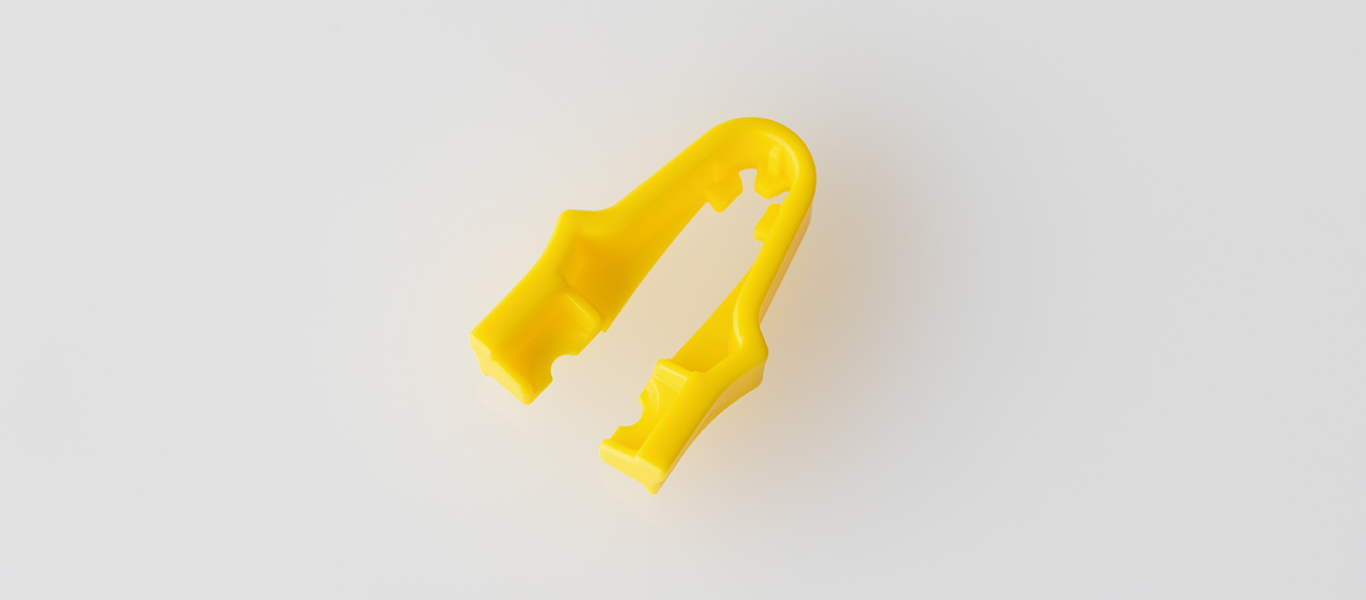
Ear hooks that alleviate cable touch noise (Incorporates lock mechanism)
An ear hook is effective in reducing touch noise; wearing it when walking dramatically reduces the unpleasant rustling sound that may occur when the cable rubs against the body (cable touch noise). In the past, our company’s ear hooks have characteristically been slimmer than ordinary and virtually indistinguishable from a wire or rosin filled cable, making it so comfortable that it is easy to forget that one is even wearing it. This time we have newly added a cable lock mechanism.
Original earpieces with a color difference between the left and right bushes.
Two types of silicon differing in rigidity are employed for the sound conduit and for the earbud that comes into contact with the user’s ear. The silicon used for the sound conduit is more rigid than that used for the earbud, and by having groove processing applied to it, combines both strength and flexibility. Soft silicon has been employed for the earbud, making for a comfortable fit and a high level of sound insulation.
One of the bushes is gray, while the other is red; by pulling the earpiece back slightly to check the color of the bush, it is easy to distinguish between left and right, even in places with subdued lighting. Since the bush colors of neighboring sizes are different (the gray bushes alternate between dark and light gray; the red bushes alternate between red and pink), it is also easy to distinguish between sizes.
Comes in 5 sizes – SS/S/M/L/LL
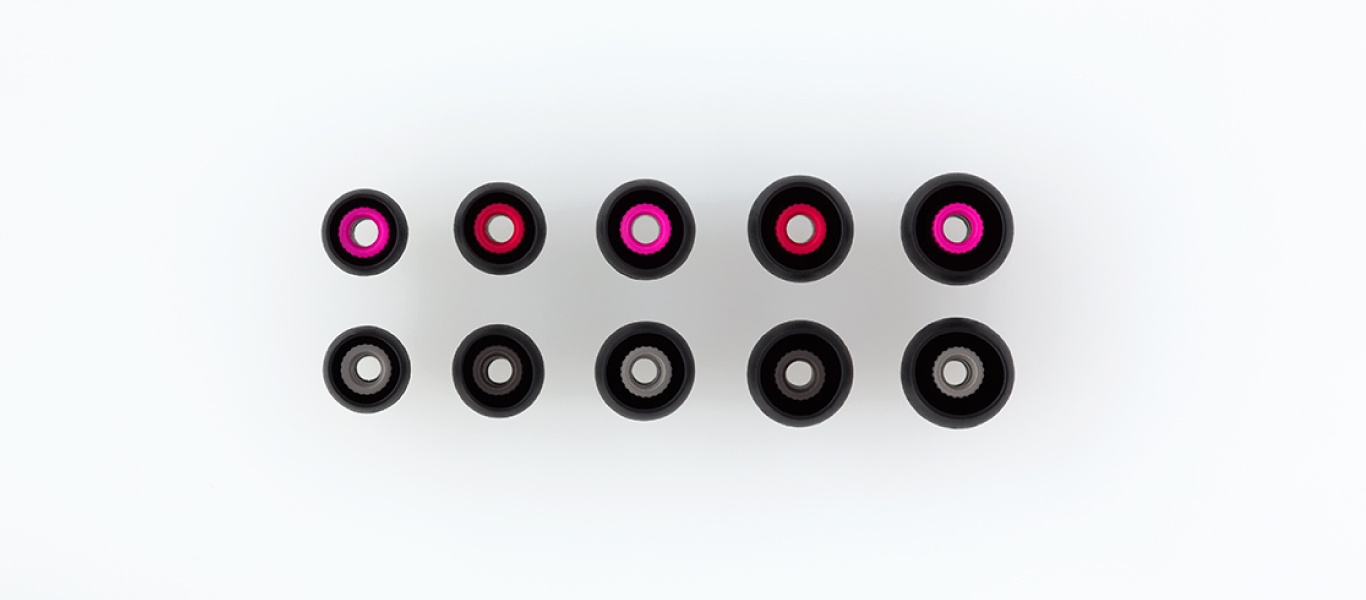
Interchangeable dust filter
The open portion of the dust filter may become soiled with earwax, etc. For the A8000, we have shaped the dust filter in such a manner that it can be removed and replaced by the customer, and a replacement dust filter is included as an accessory.
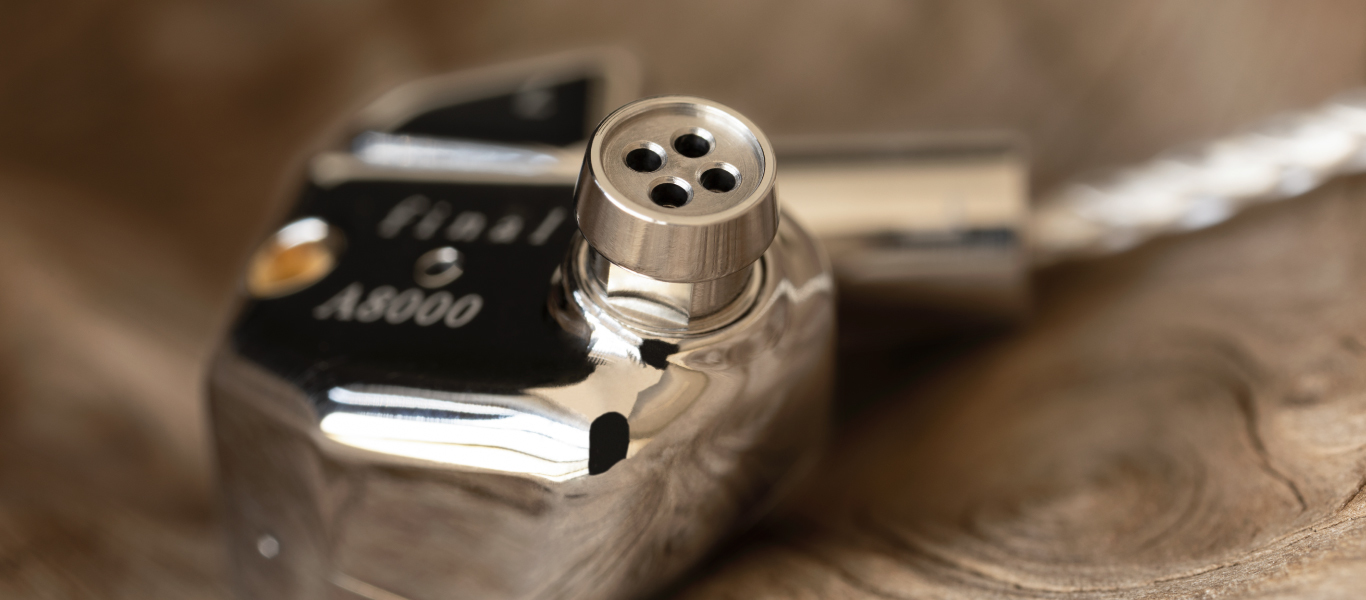
Aluminum & Silicone hybrid carry case
The aluminum carry case has been designed to strike a balance between fitting in your pocket and protecting the A8000. Cut aluminum is used for portions to which force is applied. The interior is a soft silicone dome to prevent scratching. Attention to detail is evident by other labor, such as inclusion of an internal partition to prevent the chassis from getting scratched by moving back and forth.
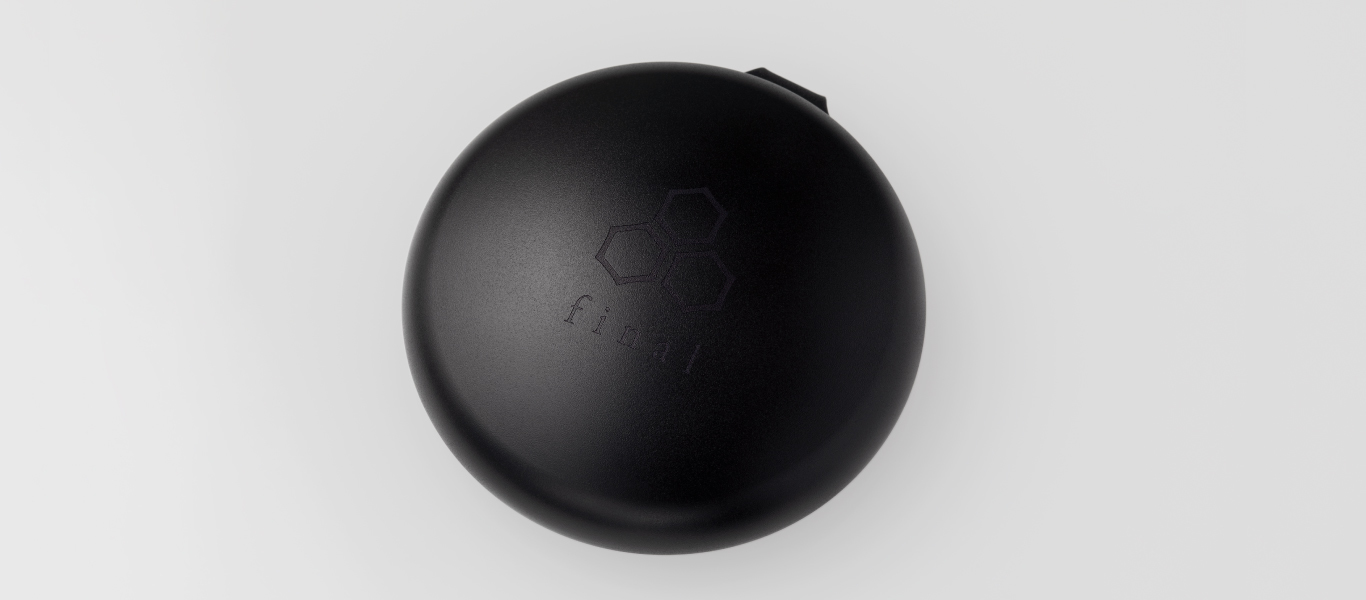
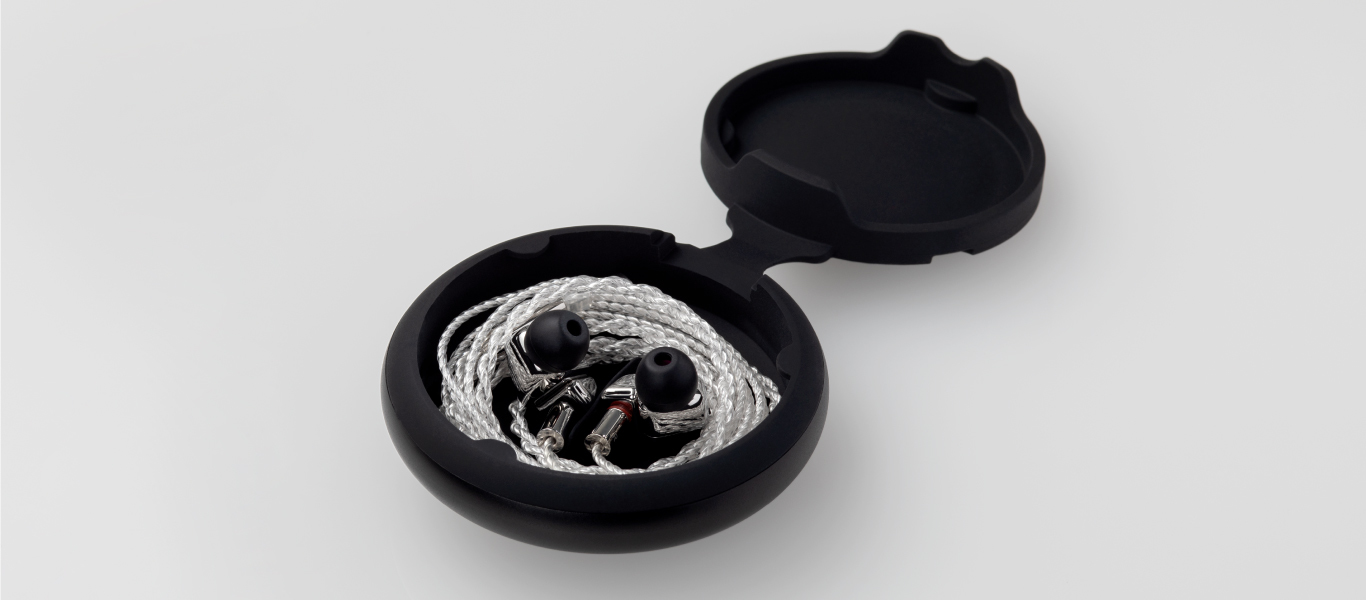
Specifications
Product code
FI-A8DSSD
Housing
Stainless
Driver
Dynamic driver(Truly Pure Beryllium Diaphragm)
Connector
MMCX
Cable
OFC silver coated cable
Sensitivity
102dB
Impedance
16Ω
Weight
41g
Cord length
1.2m
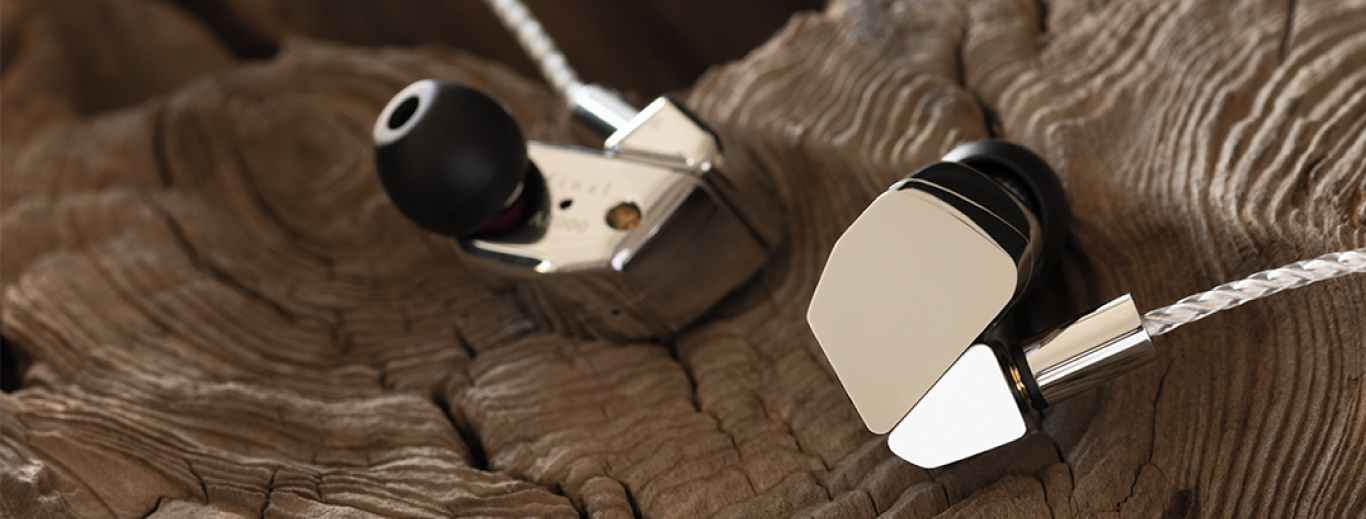
A8000
final’s flagship model realizes transparent sound for the uplift that can be gained by listening to music
Development of the A8000 began with reconstruction of physical measurement and subjective evaluation methodologies. Under the subjective evaluation methodology established at the time of D8000's development, the E Series achieved sound quality highly evaluated by many people and became a best seller. With the A8000, a new evaluation index has been incorporated into that subjective evaluation methodology. Among factors that determine sound quality for earphones and headphones, amplitude frequency response is predominant, but there are some sound impression cannot be explained by it. For example, the most critically evaluated aspect of classical music recordings is called transparent sound, a sound impression by which sound is very clear even it is localized at a distant location. We have been considering the realization of this sound impression to be extremely important for becoming uplifted by listening to music. We believe that the high evaluation of our D8000 headphones owes to the realization of such transparent sound. Until now, we have employed modification of the amplitude frequency response, known as tuning, to modify the sound of our earphones, but because it cannot make a great change to time response, it became difficult to achieve transparent sound through tuning. This time, with the aim of achieving transparent sound for earphones, final has developed its own proprietary Perceptual Transparency Measurement (PTM) evaluation methodology. As a result of evaluation and improvement of interrelations between principal components analyized by the results of subjective evaluation and data analysis of impulse response that could not be gleaned from frequency response in the past, an ideal diaphragm material that is extremely light and possessing high sound speed comprised of ultra-thin Beryllium foil (Truly Pure Beryllium Diaphragm) has been adopted for the A8000.
Features
Adoption of Truly Pure Beryllium Diaphragm
The A8000 employs a diaphragm made from ultra-thin Beryllium foil (Truly Pure Beryllium Diaphragm), which is said to be an ideal diaphragm material due to its light weight and high sound speed. With a specific gravity of 1.85 and a sound propagation velocity of 12,900 m/s, second only to that of diamond, Beryllium has ideal characteristics for a diaphragm material. The adoption of pure Beryllium will lead to improved time response that greatly transfigures sound into transparent. The sharpness of sound build-up and the lingering resonance of the sound can be clearly felt, as can the silence between sounds. Crafting thin pure Beryllium foil is difficult. Our engineers had to struggle to make it stable enough for the product, but it can be said to be a valuable material that pays off our hard works. In order to realize transparent sound through such superior materials, the same high quality has been demanded of the other components of the drive unit as well as the design and manufacturing technology. We have succeeded in leveraging the experience of developing and manufacturing our own dynamic drive unit to draw forth the advantages of pure Beryllium. ※ In the past, a Beryllium diaphragm was created by vacuum deposition of a thin coat of Beryllium onto a resin film. This was effective as an improvement methodology, but the characteristics of the film remain predominant. When pure Beryllium is used as the only material for the sound producing part of the diaphragm, the sound and characteristics are completely different.



Balancing getting an uplift from a wide range of musical genres with universally good sound.
Sound design for these models has been undertaken with attention to the relationship between spatial impression and dynamic range of music, and the physical characteristics of earphones and headphones. We have categorized sound creation on music recording onto these two axes: spatial impression and dynamic range.
One way of thinking regards the distance perception. Classical and jazz recordings are thought to be performed with emphasis on aspects of spaciousness, such as sense of distance, broadness and reverberation. On the other hand, rock, pops and many of the recent animation soundtrack recordings, spaciousness is not as highly emphasized. There is thought to be greater emphasis on clarity, which brings the various instruments and vocals to the front.
Another approach is dynamic range - in other words, changes in loudness over time. If the dynamic range is wide, naturally it is possible to use the change in loudness over time to achieve a more dynamic expression of music. But, there are some types of music for which narrower dynamic range recordings are preferable to allow each of the instruments and vocals to ordinarily appear before the listener’s eyes.
The difference between these two ways of thinking pertains not to which is superior but rather differences in how music is composed and what is demanded of it. With regard to classical music, and that played by orchestra in particular, the spatial orientation of instruments is particularly important. Stringed instruments are positioned nearest to the audience with wind and percussion placed behind them. Should the balance between the spatial orientation and volume of each group of instruments collapse, the music would disintegrate. For that reason, uniform clarity of sound that allows each instrument to appear before the eyes of the listener is not demanded of this type of music. Even for classical music, a string quartet, for example, would have a narrow dynamic range and the clarity of each instrument would be more prominent. For rock and pops on the other hand, spaciousness is not as necessary as for classical music, and so there is greater emphasis on clarity than spaciousness.
These preconditions are very important, particularly for earphone and headphone listening, and it has become apparent that the implementation of appropriate target curves and driver design result in deeper enjoyment of music.
Please refer to the below graph with spaciousness and clarity of music set on the X axis and dynamic range set on the Y axis.
The superior time response of the A8000 imparts it with sound quality that is capable of providing an uplift from a wide range of music that approaches the extent of the D Series, from the clarity of pop and rock music with a narrow dynamic range all the way to the spatial impression of classical and jazz music with a wide dynamic range. The most distinct characteristic of the A8000 is that it realizes such sound quality not by its ability to create sound capable of attracting a small number of wild fans through its strong individuality, but rather sound aimed at greater universality.

The Feeling of a Customized Fit
Based on the IEM chassis design developed for the B series that has become established as an ideal solution, the A8000 realizes a superior sense of fit. Whether or not the fit of earphones feels superior is determined by the sense of oppression. While at first glance it may seem correct to select an ergonomically praised organic shape to be held in place by the elasticity of silicon, this places ordinary pressure on the ear that serves as an unwary burden and leads to accumulation of fatigue. In limiting the area of contact in comparison to an organically shaped surface that comes in contact with a large area of the ear, this product aims for a sense of fit with no feeling of oppression. For that reason, it is suitable for the ears of many different people. If there is no feeling of oppression at any of the points of contact, that makes for such a comfortable, superior feeling of a customized earphone fit.
Precisely cut stainless steel chassis with "Tetra-Chamber Construction"
The volume and shape of the chambers in front of and behind the dynamic drive unit have a great impact on sound quality. Particularly, operation of the newly developed true Beryllium driver is extremely delicate, and it is impacted greatly by the spaces in the chassis. The internal design of the chassis can be calculated to some extent through simulations, but after that repeated trials of an actual product must be conducted until the sound quality targets are reached. For the A8000, in order to optimize operation of the driver, the inside of the driver unit chassis is divided into four chambers (Tetra-Chamber Construction); the driver ante-chamber and the double construction driver post-chamber and the MMCX connector portion are separated into different chasses. The driver is direct mounted into the ante-chamber of the chassis by a design that suppresses unnecessary vibration to achieve a distinct sound contour. Additionally, the use of four chambers achieves a balance between volume and tightness in the low-range while at the same time preventing leakage of sound.


MMCX Connector&Original high purity OFC silver coated cable
The MMCX connector was developed in-company. We've used high-purity OFC silver coated cables that provide a wide sound stage. These jointly-developed cables were originally designed by and are currently manufactured by the well-renowned Junkosha corporation for the purpose of being used with the supercomputer "Kei" due to their fast signal transmission speed. The insulator film is made from PFA which was also developed by Junkosha who used their extensive know-how through the JUNFLON® brand to create the ultimate in low-permittivity material. The outer tube is made from PVC for maximum flexibility. The user will experience surprising flexibility that both makes the cable extremely easy to use as well as reducing the likelihood of microphonics. In addition, the MMCX plug and the 3.5 mm mini-plug have a tendency to disconnect so we've far exceeded the regular QA pass criteria of a 5,000-time bend test by changing the connection design to one that can withstand more than 50,000 bends.
* Junkosha: The Japanese corporation Junkosha develops and manufactures products such as high speed coaxial cables that boast the world's fastest transmission speed at 95% the speed of light, as well as cables for demanding fields such as marine and aerospace, healthcare and power generation facilities. These special cables require a high level of technology and center around fluoropolymers. Junkosha's cables are often called by the brand name JUNFLON® and have earned the tremendous trust of engineers requiring special-purpose cables.

MMCX ASSIST for easy plug removal
An item for the smooth insertion and removal of earphone cables using an MMCX connector.
Using MMCX ASSIST the plug can be removed with surprising ease by applying proper force to the MMCX connector in the direction for cable removal,
It also prevents the contingency of the cable from becoming severed by mistakenly pulling on the cable portion of the MMCX connector plug.

Ear hooks that alleviate cable touch noise (Incorporates lock mechanism)
An ear hook is effective in reducing touch noise; wearing it when walking dramatically reduces the unpleasant rustling sound that may occur when the cable rubs against the body (cable touch noise). In the past, our company’s ear hooks have characteristically been slimmer than ordinary and virtually indistinguishable from a wire or rosin filled cable, making it so comfortable that it is easy to forget that one is even wearing it. This time we have newly added a cable lock mechanism.
Original earpieces with a color difference between the left and right bushes.
Two types of silicon differing in rigidity are employed for the sound conduit and for the earbud that comes into contact with the user’s ear. The silicon used for the sound conduit is more rigid than that used for the earbud, and by having groove processing applied to it, combines both strength and flexibility. Soft silicon has been employed for the earbud, making for a comfortable fit and a high level of sound insulation.
One of the bushes is gray, while the other is red; by pulling the earpiece back slightly to check the color of the bush, it is easy to distinguish between left and right, even in places with subdued lighting. Since the bush colors of neighboring sizes are different (the gray bushes alternate between dark and light gray; the red bushes alternate between red and pink), it is also easy to distinguish between sizes.
Comes in 5 sizes – SS/S/M/L/LL

Interchangeable dust filter
The open portion of the dust filter may become soiled with earwax, etc. For the A8000, we have shaped the dust filter in such a manner that it can be removed and replaced by the customer, and a replacement dust filter is included as an accessory.

Aluminum & Silicone hybrid carry case
The aluminum carry case has been designed to strike a balance between fitting in your pocket and protecting the A8000. Cut aluminum is used for portions to which force is applied. The interior is a soft silicone dome to prevent scratching. Attention to detail is evident by other labor, such as inclusion of an internal partition to prevent the chassis from getting scratched by moving back and forth.


Specifications
Product code
FI-A8DSSD
Housing
Stainless
Driver
Dynamic driver(Truly Pure Beryllium Diaphragm)
Connector
MMCX
Cable
OFC silver coated cable
Sensitivity
102dB
Impedance
16Ω
Weight
41g
Cord length
1.2m

Last edited:










